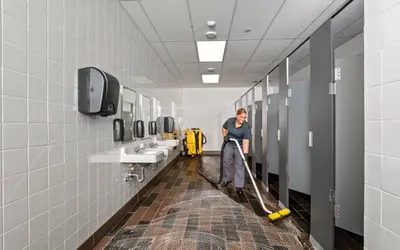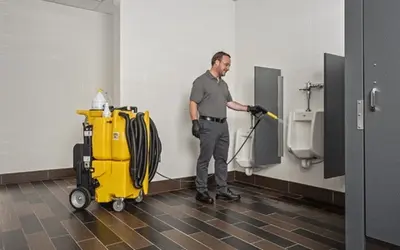Using ESSER Funds to Keep Schools Healthy and Safe

The Elementary and Secondary School Emergency Relief Fund (ESSER) expires soon. This federal grant program, administered by the U.S. Department of Education in response to the COVID-19 pandemic, totals a whopping $189.5 billion. But as of last year McKinsey & Company reports that the nation’s school districts have yet to spend the bulk of those funds.
Time to act is running out. Funds from the third ESSER package, totaling $122 billion, must be fully obligated by September 2024. Read on for ideas on how to make the most of this unprecedented opportunity.
What is ESSER?
While the U.S. Department of Education is the overseeing body, the Office of Elementary and Secondary Education is responsible for directing, coordinating, and recommending policy on everything related to elementary and secondary education. This includes administering ESSER funds.
Since the start of the COVID-19 pandemic the federal government signed three ESSER packages into law. Totaling approximately $190 billion, the emergency funds are designed to help schools create healthy learning environments, get students back to the classroom, and address local needs.
The three ESSER packages have different obligation and liquidation dates. (Obligation is when a binding written commitment for an item or service is made. Liquidation describes when the obligated item or service has been delivered and payments have been made.) The Office of Elementary & Secondary Education publishes an informative and detailed Deadlines and Announcements page, but for quick reference:
- ESSER I: Funds must by obligated by September 30, 2022 and liquidated by January 28, 2023
- ESSER II: Funds must by obligated by September 30, 2023 and liquidated by January 28, 2024
- ESSER III: Funds must by obligated by September 30, 2024 and liquidated by January 28, 2025
ESSER grants are one-time funds, meaning they will not be replaced or provided annually. States may apply for an extension to liquidate funds, but once this money is gone it’s gone. And any funds not spent or extended by the liquidation date are typically returned to the U.S. Department of Education.
How to Get ESSER Funds
ESSER funds flow from the federal government down to individual schools through a series of steps. First funds are awarded to State Education Agencies (SEAs). An SEA is the state agency primarily responsible for the supervision of the public elementary and secondary schools. (For example, the Oregon Department of Education is the SEA for Oregon.)
The SEAs then develop applications that allow the Local Education Agencies (LEAs) in their state to apply for grant funds. LEAs are the entities that administrate city, township, and district schools. Every school within a district, including charter schools, are eligible to receive ESSER funding. Individual school buildings do not apply directly for ESSER funds. They must instead go through their LEA. The LEA then applies for grant money through their SEA.
SEAs maintain web pages guidance, applications information, and more. Here is an example from New York State.
How to Use ESSER Funds
The rules around using ESSER funds are extremely flexible by design. A program or purchase qualifies as long as there is a connection between expenditures and preventing, preparing for, or responding to the COVID-19 pandemic. This Frequently Asked Questions document, produced the U.S. Department of Education, lists 20 different categories of allowable uses for the funds.
These broad guidelines make the funds eligible for disparate uses. Schools can use ESSER funds for programs and products that address learning loss, support social-emotional development, and allow for equitable access. They can also be used to bolster the safety and continuity of school operations.
Safety and continuity use cases include obligating ESSER money to purchase personal protection equipment, portable air purifiers, and cleaning and sanitizing materials. The funds can also be used to train staff on sanitation, pay overtime to salaried custodians and offer “premium pay” or additional compensation for cleaning personnel.
At present schools are using 23.9% of their ESSER funding on facilities and operations.
Using ESSER Funds for Kaivac Equipment
ESSER funding is designed to keep schools open and safe during COVID-19 and beyond.
Kaivac equipment helps school districts create and maintain clean, healthy environment so students can stay in class, learn, and thrive. In fact, Kaivac machines meet seven qualifying criteria set by ESSER.
Kaivac tools keep schools clean and safe by completely removing dirt, germs, and impurities from the environment. Many large LEAs already rely on Kaivac machines to maintain restrooms, classrooms, hallways, cafeterias, gymnasiums, and more.
School districts or other LEAs interested in using ESSER funds to purchase Kaivac should start by involving their facilities staff. This list should include key district-level employees including operations officers, facilities officers, and custodial supervisors along with other experts that can help create a cleaning/disinfection plan. This group can also educate other LEA decision makers about the link between clean school spaces and student health and morale.
ESSER funds are a once-in-a-generation opportunity to improve the health and safety of our nation’s school buildings. Investing in Kaivac technology empowers school custodians to deliver hygienically clean spaces quickly, consistently, and safely.
Don’t leave ESSER funds on the table. Contact Kaivac for more information on keeping school environments for safey and ready for students.
Related Posts

How to Clean a School Restroom
Clean school restrooms create a safe, welcoming environment. Students, staff, and parents expect sanitary conditions, especially in the restrooms. Anything less immediately effects morale and impacts learning.
Read more
Cherokee County School District Takes Cleaning into Their Own Hands With Kaivac
Each of the district’s six high schools maintained their restrooms with a No-Touch Cleaning system from Kaivac.
Read more